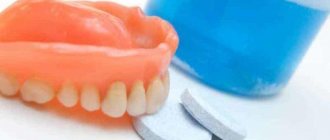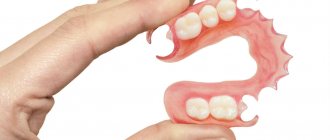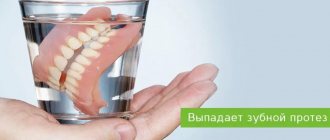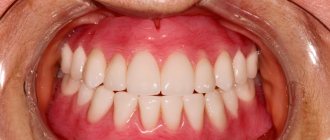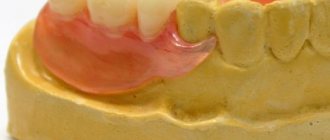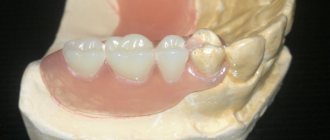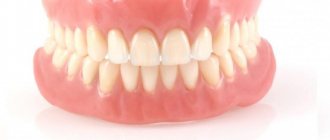How long can you wear without taking it off?
How to store? How to care? Whitening dentures Service life Dentures for many years You can restore the dentition in different ways, including removable dentures. They help restore the beauty of a smile, restore chewing function, and increase self-esteem. In order for restorations to retain their attractive appearance and last for several years, they must be looked after. Cleaning dentures and disinfecting them is an important part of care.
After installation, the dentist will definitely give recommendations on how to use dentures. He will warn that in the first days the restoration will interfere. It is necessary to prepare yourself psychologically and survive this time. It will become easier in a few days. Usually the hardest day is the first. Then a difficult 5-7 days
addictive, but they are not so intense. During this period, orthopedists advise not to remove the denture at night and generally remove it from the mouth only for cleaning.
These days, the patient practices his skills of taking off and putting on dentures, speaking when the tongue is cramped in the mouth, and chewing with unusually high teeth.
How long can you wear a prosthesis without removing it?
It is believed that the adaptation period has come to an end when the patient without dentures becomes uncomfortable. He already knows how to quickly put them on, they do not interfere with speaking, and are involved in chewing food. The period when it is better not to remove the structure is ending. Now you can take it out, but how often?
The standard recommendation is to remove the dentures at night to give your gums a chance to rest. If the denture is not removed, the hygienic condition of the oral cavity deteriorates. However, modern dentistry is characterized by an individual approach, so how often to remove dentures depends on specific circumstances. For example, with removable prosthetics, it is important how many antagonist teeth remain. In some cases, a prosthesis helps protect the remaining teeth from traumatic occlusion (touch) and overstrain. Do not remove splinted structures or restorations due to arthropathy and bruxism
[1].
The side effects of restoration can be compensated for by using prosthetic products without a palate and frequent cleaning.
Basic rule:
The less often the patient removes the prosthesis, the more carefully it needs to be looked after.
Where to put dentures at night or during bedtime
For storage, it is optimal to use a special container for dentures. It may be called a container, case, box, case, casket, etc. These containers are made from medical polypropylene, because... it does not absorb foreign odors, dyes, and is also impact-resistant. And boxes made of ordinary plastic quickly become unusable. Let's look at what containers can be (and based on these properties, a choice is made in favor of one box or another):
- with a mesh or double bottom: in such containers you can not only store the structure, but also soak it for disinfection. And after that, it’s quick and easy to take it out - it remains in the mesh, and the liquid is in the container,
- with ultrasonic cleaning: here you can also clean the prosthetic structure, and then pour out the liquid and wipe the inner walls dry,
- with a holder for the denture: it can have a protrusion in the shape of a dental arch so that the structure does not move inside,
- with a ventilated bottom: to allow surfaces to dry if there is moisture left on them,
- with lighting and mirror: for convenience when placing the orthopedic structure inside the container and further installation,
- complete with cleaning brush.
Any containers should have a convenient shape, smooth edges, an airtight lid, a secure lock that is easy to open with your hands, but will not open spontaneously in a bag. The container should be selected based on the size and shape of the prosthesis - it should not be excessively large or small so that the product inside does not hit the walls or crack from compression in a narrow space.
Read on the topic: which container to choose for a prosthesis? Here is an overview of popular containers from quality brands.
Do I need to wrap my removable denture in a clean cloth? As already mentioned, the best option for storage is an individual box with durable walls. But if it is not at hand at the moment or the cover is broken, then it is allowed to put the structure with a clean scarf or sterile bandage. And then put it on a shelf or in a case for glasses, a container for products (suitable in size and shape).
Foods to avoid
Proper care of dentures also means that you need to treat them with care. During the first time after installation, patients have to slightly change their diet. Although most foods will gradually return to your diet, some of them should be abandoned altogether. These are solid products: crackers, nuts, seeds, dried bread and bagels. Classified as unwanted
include toffee, nougat, and chewing gum. It is better to avoid food that is too hot to prevent cracks in the base.
At first, it is better not to bite off anything at all, then bite off with the side group of teeth, gradually moving to the front group.
It is important to chew food slowly, making sure that the chewing load is distributed evenly on both sides.
Tea, coffee, red wine and dark berries create conditions for discoloration of restorations. This should also be kept in mind when choosing drinks and food.
This is especially true for acrylic plastics. They are permeated with micropores in which pigments easily accumulate. More modern materials such as Acry Free or QuattroTi are dye resistant.
Cost of storage and care kit
A set of tools for caring for and storing removable dentures may include the following:
- container,
- ultrasonic cleaning bath,
- disinfection solution or tablets,
- cleaning brush,
- special cleaning paste.
The minimum cost of such a kit is about 1000 rubles, but it all depends on which brand the patient prefers. If these are high-quality foreign funds, then the cost can be several times higher.
Don't know what type of prosthetics to choose?
We will help in the selection, advise where to read more information and compare types of prosthetics.
Consultation with an orthopedic doctor in Moscow clinics is free! Call now or request a call
Working hours: from 9:00 to 21:00 - seven days a week
How to store
The best place to store dentures is in a special container. As a last resort, you can put it in a glass of water or wrap it in a damp cloth. To store dentures at night and between uses:
- away from children and animals;
- in a special solution or cooled boiled water. Do not immerse in boiling water or tap water, which contains many impurities.
Whether to place the product in water or a special storage solution largely depends on the material
. Modern thermoalloys do not need a humid environment, but classic acrylic ones can dry out without water. Your dentist will advise you on how to properly store dentures, taking into account the material of construction.
What problems arise when stored incorrectly?
If you do not know how to properly store removable dentures, or do not follow the already known storage rules, the following problems may arise:
- deformation due to prolonged exposure to liquid,
- deformation due to overheating or hypothermia,
- overdrying negatively affects the performance properties of materials: microcracks and detachments may appear (where food debris will become clogged),
- the appearance of pigment spots, bacterial film and growths due to careless care or storage in unsuitable conditions,
- chips and cracks due to falls and systematic mild mechanical impacts (when shaking in a large container).
How to care for dentures
A side effect of removable dentures is a change in the microflora of the oral cavity. Because of the prosthesis, the palate and gums stop cleaning themselves. Bacteria accumulate in the mouth, especially at the points of attachment to the crown of the tooth, if the structure is partial. The longer a restoration is used, the more it is exposed to biocontamination.
Proper care has a great impact on the service life of removable structures. It is multi-stage, but in reality it does not require much time and effort.
In dentistry, there are mechanical, chemical, and physical methods of cleaning restorations.
Mechanical cleaning
carried out with a special toothbrush. The fact that it has bristles on both sides helps to effectively clean removable dentures from plaque. The longer one is for processing the outside, and the short one is for the inside. The heads are either straight or crescent-shaped.
An orthopedic dentist will definitely tell you how to clean your dentures. The brush should be soft, usually written “soft” on the packaging, and the paste should be low-forming. The abrasiveness coefficient is indicated on the packaging under the letter RDA
.
For nylon and Acry Free bases, it is best to choose a paste with zero abrasiveness
. These are produced for children under 3 years of age. Instead of toothpaste, you can use liquid soap.
Acrylic bases can be cleaned with a paste with an abrasiveness of up to 25
. For ordinary pastes, this coefficient is 60 or higher. Whitening pastes are not recommended.
Chemical cleaning
- This is soaking in disinfectant solutions. The structure is immersed in the prepared solution or a special tablet is added to the water. Such products are sold in pharmacies. The most famous brands: Corega and Protefix. These products destroy bacterial plaque, which can cause diseases of the mucous membrane and cause an unpleasant odor from the prosthesis. After being in the solution, the structure emits a pleasant aroma.
However, in case of heavy contamination, such disinfection does not provide 100% cleaning. If a layer of pigment or tartar has formed on the product, home care tablets for removable plastic dentures will not help. Here they use polishing at the dentist or ultrasound.
Physical cleaning
Ultrasound is suitable for complete dentures made of any material. Ultrasound passes through the liquid, creating bubbles on the surface of the restoration, which, when bursting, help clear plaque on the dentures, clean them of food debris and dirt, even from hard-to-reach places. 10-20 minutes in such a bath and not a trace remains of bacterial plaque. The higher the power of the ultrasonic bath, the better it cleans the surface.
After each meal, it is recommended to rinse the restoration under running water. The cleaner the denture, the more comfortable it feels in the mouth. A structure covered with plaque and stains wears out faster. In addition, dirt and bacterial film provoke inflammatory processes in the oral cavity. With proper and regular use of cleaning products, restorations retain their attractive appearance for a long time.
If the structure has become dull and shows signs of pigmentation, you can contact your dentist and he will send the denture for polishing.
What is prosthesis correction and when should it be done?
After applying removable dentures in the oral cavity, as a rule, pain appears in some areas underneath. This is due to the inevitable gradual subsidence (pressure) of the removable denture on the mucous membrane. This factor cannot be fully taken into account when designing these orthopedic structures, therefore, correction is necessary to eliminate unpleasant sensations. It consists of “undermining” the dentures in those areas where it presses on the oral mucosa.
The first correction must be carried out the next day after the start of using dentures. The next 3-4 corrections must be carried out over a period of one and a half to two weeks as necessary. You may need more visits to the dentist after completing your work (up to 10).
In case of severe pain, you need to remove your dentures and put them in a special container or glass of water. Before going to the doctor for correction, you must wear dentures and walk around with them for at least 3-4 hours. This will allow the doctor to see a clear imprint on the mucous membrane and correct only the place that is rubbing the gum. Bringing a denture in your pocket and pointing your finger in your mouth is useless. In removable dentures, every centimeter, and sometimes even a millimeter, of the supporting surface is of great importance. If the correction is inaccurate, the fixation of the prosthesis may be impaired. This is exactly what happens if you try to grind or file dentures yourself. After correction (adjustment) of removable dentures, you must not use them for 1 day. During this period (during the healing period of the namin), it is advisable to rinse your mouth and make baths (hold the solution in the mouth at the site of the namin) with herbal decoctions. Use a decoction of chamomile flowers, oak bark, etc. For example, take 0.5 tablespoons of dry oak bark, brew in one glass of boiling water, cool, apply the decoction 3-5 times a day. You can also use medicines, for example Kamistad gel, sold in pharmacies.
Feel free to visit your dentist for adjustments. Removable dentures, even if they are made in the most careful manner, require correction. Even if you do not experience any pain or discomfort, you should visit the dentist for an oral examination.
WARNING : Do not attempt to straighten dentures yourself with a file or any other tool. This can lead to breakage of the prosthesis and disruption of its fixation. Moreover, after such “repairs” it is no longer possible to do anything with the prostheses in the clinic. As a result, all that remains is the manufacture of new orthopedic structures.
Whitening dentures
Pigmentation and brown deposits can ruin the appearance of any restoration. Regular oral care with dentures prolongs the life of the dentures and maintains the aesthetics of the structure. But whitening pastes only cause harm. They contain too many abrasives that scratch the plastic. The surface of artificial teeth is not as strong as that of natural teeth and is easily damaged.
The acids in home whitening kits are simply dangerous. The reaction of their components with prosthetic materials can lead to unpredictable, life-threatening results.
To whiten dentures at home, it is better to use special products. For example, Corega whitening tablets. They carefully clean the surface without harming it, eliminate unpleasant odors and remove stains. The tablets slightly lighten artificial teeth, simultaneously destroying pathogenic microflora,
What antiseptics are used for orthopedic structures
Antiseptic solutions for disinfection can be produced in several versions:
- in finished form (liquid or con or CURAPROX weekly (“Curaprox weekly”),
- in the form of tablets for preparing a solution at home: for example, Corega tablets and Protefix tablets.
In general, soaking for the purpose of disinfection or removal of old plaque, but not for storing the product, is recommended to be carried out once a week. How long should removable dentures (plastic and other) be soaked? The orthopedic structure is immersed in the solution for only 3-15 minutes, then removed, washed and dried with a clean cloth. Each manufacturer sets its own “holding” or soaking time, and it is unsafe to exceed it, because chemicals can damage materials.
Life time
If you wear your denture correctly and take good care of it, it will retain its original appearance for a long time. But after a maximum of 5 years
it will still have to be changed. This is due to the fact that removable dentures do not stop bone loss. Over the years, the gums sag, the topography of the mouth changes and the prosthesis no longer fits. In the first years, correction and relining help, but over time, the changes become so pronounced that only a new prosthesis can save the situation.
What to do if your prosthesis breaks?
During the use of removable dentures, a fracture of the prosthesis or its individual parts (tooth, clasp) may occur. In this case, you need to consult a dentist. If a tooth(s) on which partial removable dentures are held or supported are lost, it is possible to weld an artificial tooth to the denture in place of the lost one. Repairing a removable denture takes 2-3 days. Repairs are made without warranty.
In case of cracks, fractures, etc. Do not try to fix the denture yourself, even if urgently. Only specialists can repair the prosthesis.
Making new removable dentures takes about 1 week. The warranty period for plastic removable and clasp dentures is usually up to 1 year. During the warranty period, the prosthesis is repaired or altered free of charge. After the warranty period expires, the work is paid in full.
What features do “clasps” have?
Clasp orthopedic structures have several key features and differences from other “pullers” - a metal arch at the base, a small palatal bridge and several ways to attach the prosthesis to the teeth. Let's look at these features below.
South Korean implant Osstem - 20,000 rub.
Hurry up to sign up for a free consultation and lock in promotional prices.
Call now or request a call
Opening hours: 24 hours a day - seven days a week
Presence of a metal arc
The clasp prosthesis differs from all other removable orthopedic structures in that it has a rigid metal frame - this is the clasp or arch. It runs along the entire base, i.e. both in areas hidden by artificial gum, and in areas “free” from the gingival base - usually along a group of preserved teeth. Allows high-quality distribution of chewing pressure compared to other removable ones, therefore it is more comfortable to wear and use - it does not rub and copes with chewing food.
Features of dentures for the upper jaw
Another difference is the presence of a metal palatal bridge (for upper jaw prosthetics). It is also made of metal, but this structural element is not as massive as, for example, a plate prosthesis. In a clasp, the palatal bridge looks like a thin bridge or ring (there may be several options here), but in any case it takes up little space in the oral cavity.
Attaching the clasp structure to the teeth
Next, you need to dwell on the fastening elements of the clasp prosthesis; it can be of the following varieties - hooks (clasps), locks1 (attachments), telescopic crowns. Retainers are usually made of metal. But, for example, attachments can be partially “hidden” in the crowns or base of the prosthesis. To improve aesthetics, the upper parts of telescopic crowns are covered with light materials - ceramics, composite and others.
A few words about product care
The storage of clasp dentures and the preservation of their appearance, as well as performance characteristics, are inextricably linked with proper care. What needs to be done to ensure that the clasp always looks like new and lasts for many years, we will tell you further:
- cleaning the denture 2 times a day using a special brush and paste,
- disinfection in a solution once every 7-10 days (on the recommendation of a doctor, a short soak in the solution can be carried out daily),
- high-quality cleaning of your own teeth: so that plaque and germs from them do not get onto the artificial “jaw”,
- rinsing your mouth with clean water after every meal,
- It is recommended to purchase an irrigator and an ultrasonic bath for better hygiene,
- refusal of hard products: they can leave scratches on the base or break it, damage metal fasteners, lead to “misalignment” of the arc,
- avoidance of stretchy products: they can disrupt the connection of different elements of the prosthesis,
- visits to an orthopedic dentist for preventive examinations 1-2 times a year.
It is forbidden to clean the clasp denture with highly abrasive toothpaste, with a brush with very hard bristles, or soak it in aggressive solutions - for example, in vinegar.
What affects the wear of materials and elements
The artificial materials from which clasp dentures (and any others) are made cannot be independently renewed and restored, like natural fabrics. We are talking about the natural process of enamel remineralization (calcium saturation) or gum regeneration. Of course, you need to take care of your own teeth and gums, but also artificial ones. What many people forget about, believing that since such “teeth” cannot hurt, then there is no need to care for them. Therefore, some factors can lead to early wear of the orthopedic structure. Let's look at them in more detail:
- poor-quality care: irregular cleaning, an abundance of soft and sweet foods in the diet - combined with the lack of rinsing the mouth after such meals, refusal of professional cleaning 1-2 times a year in a clinic,
- too much force when cleaning: you can scratch the acrylic base or break the fasteners,
- incorrectly selected hygiene products: it can be either a very hard brush or a soft one - the first leaves scratches, the second cannot cope with plaque. Toothpaste with a large amount of abrasive particles also scratches the material, which reduces its service life. Dyes and pieces of food get clogged into microcracks - the material darkens, becomes dull, and may emit an unpleasant odor,
- exposure to harsh chemicals or extreme temperature changes,
- storage in an inappropriate place,
- eating very hard foods, chewing nut shells, etc.
How to choose a storage container
Storing dentures is a very important issue for patients who wear orthodontic appliances. Manufacturers of dental products have developed special containers. Special chests protect products from pathogenic bacteria. The material of high-quality cases is medical polypropylene. It does not deteriorate over time. Its design is such that the patient does not have to put his fingers into the solution. The device is easy to get out using the holder that is installed on the mesh.
Convenient to perform disinfection procedures. You cannot do without such a case on the road if the prosthesis needs to be transported for restoration work. It is unacceptable to shake fragile false teeth in a travel bag. They are securely fixed in a special chest. High-quality containers close tightly and have built-in mesh separators. It is important that the box is deep, then the solution will completely cover the product. It’s good if the chest has a built-in mirror so that you can put the device on while on the road. It is not advisable to purchase cases made of plastic, as it can become deformed.
The best drawers for dentures are those that follow their shape. This saves the amount of disinfectant solution to be poured. The weight of such a case will be insignificant. It will be convenient to carry with you. Many modern containers have a mesh bottom. This allows the solution to drain back into the box after the denture is removed. Therefore, there is no need to change it every time. Among modern models, the following cases stand out:
- Conventional containers that consist of one body.
- Boxes with a mesh type separator.
- Ultrasonic models that clean false teeth from plaque and food debris. The devices disinfect and sterilize orthodontic appliances.
- Illuminated drawers are suitable for patients with low vision. Additional lighting helps to remove the structure from the tank.
There is great demand for Bradex containers. Polypropylene containers from the Swiss manufacturer Curaprox are popular. Sonic Denture Cleaner products are equipped with an ultrasonic cleaning system. In a short time, the machine will clean the artificial units on its own. True, such models can only be used at home. Denton polypropylene cases are equipped with built-in lighting. The German company produces Miradent models. They are complemented by a mirror and a brush.
How often should you remove the clasps?
Understanding how to properly store a clasp denture and how often it needs to be removed from the mouth, it is worth knowing that in the first days or even weeks after installation, dentists advise not to remove it at all. This is necessary for faster adaptation to the artificial structure. And those patients who followed this advice got used to the new teeth in 2-4 weeks - diction and articulation, salivation became normal, and eating became easier. But the fact that the prosthesis is constantly “stored” in the mouth does not exclude adequate care for it. Otherwise, stomatitis may occur, bad breath will appear, and in general the artificial material will take on an unaesthetic appearance due to food and bacterial plaque.
REPROSTHETOSIS WITH ACRYLIC PROSTHETICS - RUB 180,000!
Re-prosthetics with an acrylic bridge on a metal frame (all included) up to 12 units.
Call now or request a call
